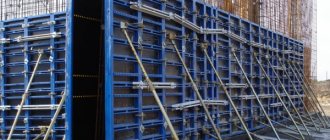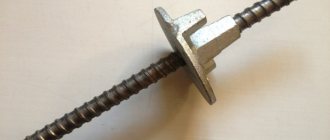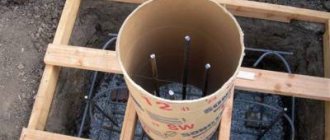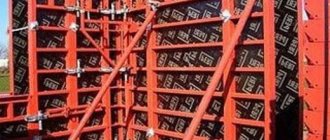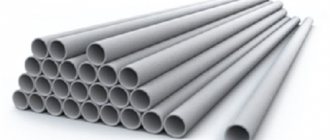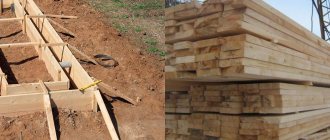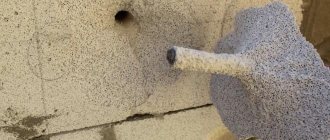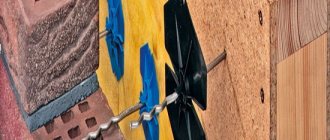When constructing any monolithic structure, you cannot do without assembling the formwork. These are special forms that give concrete the shapes specified by the project. It is very important that the formwork is strong enough so that the pressure of the concrete mixture does not cause its deformation.
When pouring small elements, it is often enough to install slopes and external supports. If something massive is being built, then something more significant and durable is needed to fix the shields. In this case, a tie screw is used for the formwork.
What are they?
The size range of formwork fasteners is now quite wide.
Their strength according to DIN 18216 can range from 85 to 240 kN. For the manufacture of such bolts, steel from St20 to St35 is used. Size M16 is relatively rare. Products with a diameter of 15, 20 or 25 mm are much more common. Structures with a cross-section of 15 mm have an actual cross-section of 177 mm2. The specific gravity of 1 m of rolled stock in this case will be 1.38 kg. The maximum deviation for all indicators is assumed to be 4%. With a cross section of 20 mm these parameters are:
- 314 mm2;
- 2.44 kg;
- 4%.
With a cross section of 25 mm they will be:
- 490 mm2;
- 3.8 kg;
- 4%.
Pinch screw(bolt) and nut
The kit for fixing formwork sheets consists of tension screws, which are metal rods with a regular thread cut along the entire length and special screw-on nuts, the head of which is of a universal type. The external diametrical size of the thread is 17 mm, and its internal value is 15 mm.
The thrust elements for formwork panels are two nuts, which are screwed on both sides along the screw thread. In order to improve the stop in front of the nut, as a rule, massive square-shaped washers are installed.
- The standard size of such a thrust element is 18 mm.
- Factories that manufacture formwork equipment produce tie screws for formwork of various sizes, ranging from 0.5 m to 3 m.
This production demand factor is caused by the fact that, in terms of technical parameters, formwork panels for the construction of monolithic foundations, walls, columns and ceilings have significant differences.
In order to make the right choice of fixing elements for formwork, the following technical points must be strictly taken into account:
- thickness of monolithic walls;
- the thickness of the shields, to which it is necessary to add a spare length of 300 mm for screwing nuts and installing thrust elements in the form of washers.
To avoid the appearance of corrosion on the rod fixing elements, it is necessary to use special metal sleeves into which they are inserted during the assembly of the formwork structure. Such sleeves greatly facilitate the dismantling of screw connectors when disassembling panels.
Why are clamping screws needed?
The use of formwork tie screws is necessary to construct formwork that can withstand the pressure of the concrete mixture. If you assemble the formwork incorrectly, then after pouring the concrete solution, the panels will simply move apart under the pressure exerted on them.
As a result, instead of the desired structure, the unfortunate builder will receive a shapeless concrete formation. To prevent the shields from diverging, when performing monolithic work, a fastening screw complete with nuts is used.
Installation
A pair of special nuts helps secure the formwork tie screw. They must be precisely cast from a particularly strong or malleable grade of cast iron. To avoid difficulties with screwing the nut onto the bolt, the chamfer is removed to insert it. In this case, the area of contact with the formwork panel increases. Usually it is 90 - 100 mm.
But in particularly difficult situations, due to the additional installation of washers with a cross-section of up to 180 mm, the size of the contact area increases even more. A polymer pipe will help prevent the concrete mixture from destroying the screws. Thanks to it, further dismantling of the formwork is greatly simplified. The external cross-section of the threaded tie should be 1.7 cm, and inside it is 1.5 cm. The thread is usually melted immediately, but it can be cut later.
This fastener is universal and compatible with formwork of any shape and size. Therefore, it can be used when working with a variety of types of monolithic wall blocks. Additionally, a plastic tube is used (which should be larger in cross-section than the bolt). Cone clamps are inserted on both sides of the pipe. When installing a clamping block without plastic protection, reuse is impossible; If such protection is used, the bolt can be removed quite easily.
The best results are achieved by formwork bolts made from lightly alloyed steel. They are made using hot rolling. For your information: in professional sources the same product may be called simply a “tie”, an anchor rod or even a “hairpin”. Together with the coupling bolt the following can be used:
- lamb;
- hexagonal;
- a hinged type of nut.
Before installing the shields inside them, it is necessary to drill channels of a suitable cross-section. If a standard coupling bolt is used, ties with a diameter of 2.2 cm are used. The channels should be punched not at the edge itself, but at least 10 cm from the edge. A fixing cone, a plastic pipe and the next fixing cone are attached to the inserted bolt. The opposite edge of the pin exits through a special hole in the other shield; the edges of the bolt extend beyond the shields to the extent that the nuts are freely fastened, and washers can be placed in front of them.
The following video talks about the pinch bolt.
Installation and dismantling
When assembling formwork forms, it is very important to install the ties correctly. Basic rules for its installation:
- Before installing the panels, holes of the required size are drilled in them to install the ties. When using standard fasteners, the diameter of the tie should be 22 mm;
Advice! The holes for installing the ties are not drilled at the very edge, but at least 10 cm away from the edge.
- shields are mounted on site, according to the project;
- A bolt is inserted into the prepared hole on one of the panels. Protective parts are put on it in the following order: retainer-cone, plastic pipe, retainer-cone. The opposite end of the stud is brought out through the mounting hole on the opposite panel. The ends of the bolt must extend beyond the outer parts of the panels so that the nuts can be secured. Therefore, the length of the bolt is selected depending on the planned thickness of the structure being built;
- washers are strung on the tie rods on both sides and nuts are attached;
- The nuts are tightened along the threads, adjusting the distance between the panels in accordance with the designed thickness of the monolithic object being built.
After the concrete mixture has hardened, the screeds are dismantled, for this:
- unscrew the nuts on both sides of the coupling screw;
- washers are removed;
- The pin is removed from the tube, the tube itself and the retainer remain in the concrete solution.
So, tension screws are an important part of any formwork structure. Thanks to this element, the shields are held in a given position without moving apart under the pressure of the concrete solution poured into them. When choosing fasteners for formwork installation, it is important to give preference to products manufactured in accordance with GOST requirements. Otherwise, it will be difficult to guarantee the strength of the assembly.
What types of furniture hardware are there?
When assembling soft corners or sofas, furniture bolts and screws are used that comply with GOST 7801. The heads of such bolts can be semicircular or with a mustache (the mustache saves the screw from turning). To make the fastening more reliable, special flat washers are installed. Their sizes may vary. Most often, bolts with M6 threads with a length of 30-40 mm are used.
Tightening parts are convenient for working with different materials. They are installed on furniture made of wood, multi-layer plywood or chipboard.
Reliability of fastening is ensured by precise markings. Tightening hardware can be made with a countersunk head installed in a specially prepared hole. In mass production, parts 5 × 50 and 7 × 50 are used. Their appearance is made of galvanized imitation or yellow passivation is applied.
The tie occurs by screwing one part of the bolt into another
If there are hidden places in the set, furniture bolts are installed without a protective layer. True, such parts are used only for products operated at low humidity levels.
In case of high humidity, fittings with a zinc coating are installed, which reliably protects them. Sometimes parts are chrome-plated to give a beautiful appearance.
A striking representative of such products was the furniture bolt “Din 603”. It is made in the form of a cylindrical rod ending in a head. The thread is cut entirely or has only a specific length. To create a powerful connection, a special nut is used.
This fastening is characterized by increased strength, so it is used not only for fastening wooden products, but also for assembling metal structures. If we talk about furniture, then a similar furniture bolt is used in garden sets made of thin sheet metal.
Furniture bolt “DIN 603” 10x45
Peculiarities
The construction of various buildings and structures is unthinkable without many connections. And in many cases it is possible to make these same connections using coupling bolts. This type of fittings is becoming more popular every year. Unlike the same concrete screed, it is easily dismantled and, if necessary, restored or moved to a new location. In addition, the installation time is significantly longer than when using other options, and there is not much difference in reliability.
This type of fastener is subject to GOST 7798-70. According to this standard, a hexagonal head of accuracy category B must be used. The thread cross-section ranges from 6 to 48 mm. Additionally, it is worth considering the use of GOST R 57899-2017. This standard sets out general technical conditions for anchors and ties used in formwork.
A high-quality tie bolt connects the formwork quite effectively. Mechanical deformation of concrete mixtures is excluded. This property is typical even when installing heavy, powerful structures.
Technical specifications
Tie hardware is made of carbon steel. To make the part resist corrosion, it is coated with a layer of zinc, sometimes even chrome plated. There are copper or brass products. If the installed furniture is handled carefully and is not subjected to heavy loads, such parts will be used for many years.
The clamping screws for the handles are equipped with threads. The length of the part is in the range of 2-20 cm. It all depends on the thickness of the material to which the handle is attached. Together with the screws, the furniture is equipped with nuts and special washers corresponding to the dimensions of the part.
M6 clamping screw with cylindrical head
The use of tie bolts for formwork assembly
The formwork for concrete work must be strong enough, because the solution exerts considerable pressure on it. In most cases, struts and pegs driven into the ground with strapping are sufficient, which prevent the shields from spreading to the sides. But when casting powerful structures, you will need a more serious fastening - a clamping screw.
Description
We are talking about an anchor rod - a profiled reinforcement with a cut thread with a diameter of 17 mm. The length of the pin can be any - from half a meter to 6 m - it all depends on the thickness of the casting. Such a device is indispensable in the construction of monolithic structures and is suitable for strengthening both horizontal and vertical formwork.
At the same time, the screed allows you to adjust the width of the concrete form with an accuracy of millimeters, optimizing the consumption of the solution (not to mention reducing its losses when flowing out through the cracks). Elements are easier and faster to dismantle, after which they can be reused. There is also a more modern device - mounting clamps.
Characteristics and purpose of the screed
The coupling bolts are made of steel - black (St20, St35, 35GL) or with protective galvanization. They are quite heavy in weight (1.2-1.4 kg/lm), but durable and can withstand heavy loads from 11 to 16 tons. There are also composite screws made from lightweight fiberglass on the construction market. These are low cost, corrosion resistant and do not conduct electricity. But they have average strength characteristics - one pin holds only 600 kg, and with repeated use - 250 kg.
The shear resistance of composite bolts is low, and under the influence of transverse forces they simply break. Their consumption turns out to be much greater - 4-8 screws are required for 1 m2 of shields. Among such devices you can find inexpensive disposable kits for use with permanent forms.
The screed is primarily necessary to reduce the pressure of the concrete mixture on it. Thanks to the use of such a system, the load is evenly distributed across the parallel walls of the mold. Without a rigid bond, the solution will simply squeeze out the shields and flow out. The fastening can be installed on any tier of permanent formwork to increase the reliability and quality of casting future walls.
Equipment and installation features
The anchor rod itself is not capable of holding the form walls under concrete pressure, so the kit always includes formwork tie screws, nuts and washers. To protect metal fittings from contact with the solution, a special casing is put on it. This is a PVC pipe with a diameter of 22 mm, which remains in the monolith after stripping.
The coupling nuts are cast from VCh-40 cast iron or 35GL steel. They also have an anti-corrosion galvanized coating and are capable of holding a load of up to 14 tons with a dead weight of 570-650 g. They are distinguished by the diameter of the flat support platform (80, 90 or 100 mm), but this does not change the characteristics of the hardware.
As for the washer, its functions are standard. A flat piece of sheet iron 100x100 or 150x150 mm is only required to prevent the nut on the screw from cutting into the surface of the plywood panel, but to evenly distribute the pressure over its entire area. Square pads are usually 4-5 mm thick and weigh from 0.4 to 1 kg.
In total, for a reliable connection of two standard opposing slabs, you need to purchase at least 3-4 sets of ties. In terms of their area, the consumption per 1 m2 is small - it is enough to install the screws half a meter apart in two rows. Each of them will require an additional 2 washers and 2 nuts.
Installation procedure:
- Before installing the decks, through holes with a diameter of 22 mm are drilled into them (to accommodate the PVC pipe).
- A tie bolt for the formwork is inserted inside the plastic casing, stitching parallel panels.
- Washers are threaded onto the rod on both sides and flange nuts are attached.
- By tightening the hardware along the thread, the distance between the walls is adjusted in accordance with the thickness of the future casting.
The screws must be placed not at the very edges of the boards, but with an indentation of at least 10 cm. A pair of screeds is mounted in the upper and central part of the deck, and from below it is simply spread out with struts to reduce the consumption of anchors.
Price
The number of screeds is determined by the size of the future monolith and the pressure of the cement mixture. Knowing the characteristics of screws and nuts, you can calculate their installation pitch and number. Builders are guided by indicators for heavy concrete - it acts on the panels with a force of 370 kg/l.m.
| Name | Quantity | Price, rubles |
| Steel coupling bolt | 1m | 100 |
| Nut VCh-40 (d-90 mm) | 1 PC. | 90 |
| Nut VCh-40 (d-100) | 1 PC. | 130 |
| Nut 35GL | 1 PC. | 260 |
| PVC pipe (d-22) | 1m | 18 |
| Washer | 1 PC. | 50 |
| Fiberglass screed | set | 132 |
It is better to buy materials with a reserve, especially the PVC casing - it will remain in the monolith even after the formwork is dismantled. All other elements can be reused. If you only need them for a one-time job, it is better to buy used tensioning kits - their cost is almost half as much.
